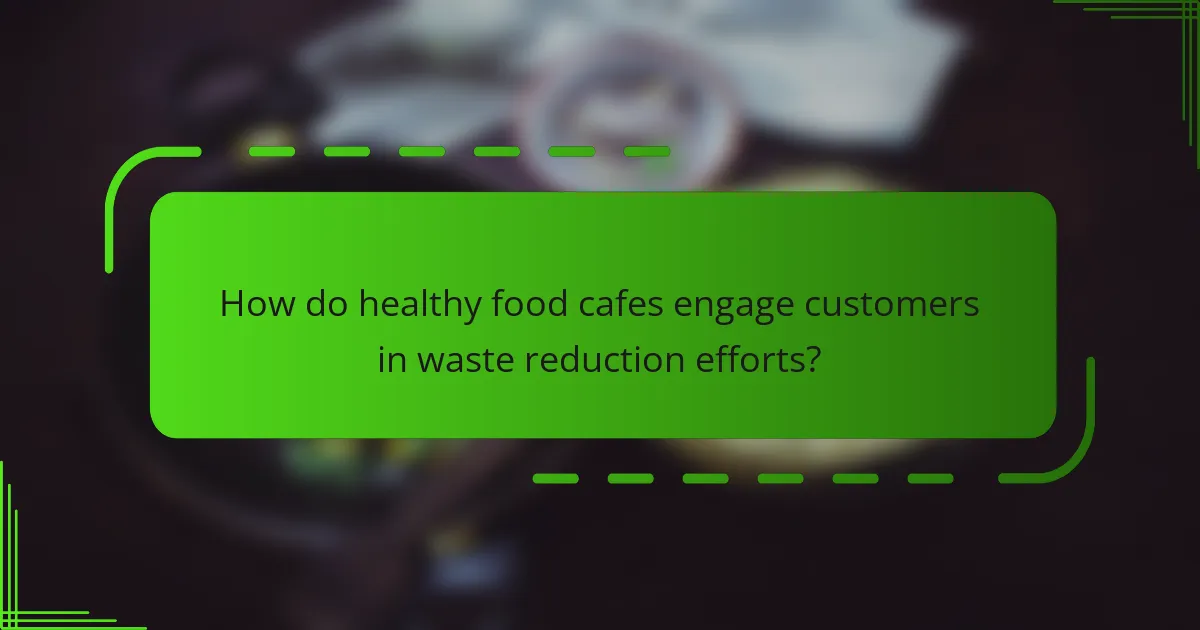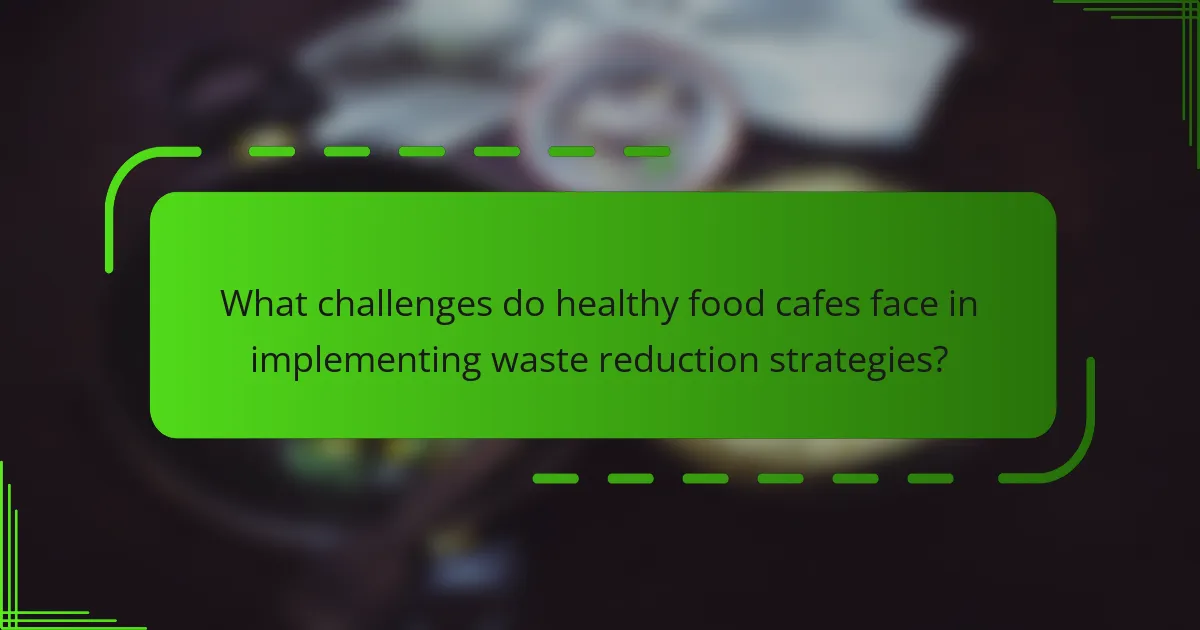Healthy food cafes are establishments that prioritize nutritious offerings while implementing waste reduction strategies to promote environmental sustainability. These cafes source local ingredients to minimize transportation waste, utilize composting for organic waste, and adopt zero-waste policies encouraging the use of reusable containers. They engage customers through educational initiatives and partnerships with food recovery organizations to donate excess food. Despite facing challenges such as limited resources, fluctuating consumer demand, and regulatory compliance, these cafes strive to foster a culture of sustainability and resource efficiency within their communities.

What are Waste Reduction Strategies Implemented by Healthy Food Cafes?
Healthy food cafes implement various waste reduction strategies. These include sourcing local ingredients to minimize transportation waste. They also utilize composting for organic waste, which reduces landfill contributions. Many cafes adopt a zero-waste policy, encouraging customers to bring reusable containers. Additionally, they often track inventory closely to prevent over-ordering and spoilage. Some cafes partner with food recovery organizations to donate excess food. Implementing digital menus reduces paper waste significantly. These strategies collectively contribute to environmental sustainability and resource efficiency.
How do healthy food cafes define waste reduction?
Healthy food cafes define waste reduction as minimizing food waste throughout their operations. They implement strategies such as sourcing local ingredients to reduce transportation waste. Many cafes also practice portion control, ensuring customers receive appropriate serving sizes. Composting organic waste is a common practice among these establishments. Additionally, they often repurpose unused food into new dishes or ingredients. Educating staff about waste management is also emphasized. Studies show that cafes adopting these practices can significantly reduce waste by up to 30%. This commitment to sustainability is reflected in their overall operational philosophy.
What types of waste are commonly generated in healthy food cafes?
Healthy food cafes commonly generate organic waste, packaging waste, and food waste. Organic waste includes vegetable scraps, fruit peels, and leftover food. Packaging waste consists of containers, wrappers, and bags from takeout orders. Food waste arises from unsold perishable items and customer leftovers. According to the Food Waste Reduction Toolkit, cafes can contribute significantly to food waste in urban areas. This waste not only affects the environment but also represents lost resources. Implementing waste reduction strategies can help mitigate these types of waste.
How is waste reduction measured in these establishments?
Waste reduction in healthy food cafes is measured through various metrics. Common methods include tracking the volume of waste generated over time. Establishments often use waste audits to categorize waste types. They analyze food waste, packaging waste, and compostable materials. Key performance indicators (KPIs) such as waste diversion rates are also utilized. This measures the percentage of waste diverted from landfills. Establishments may compare waste data before and after implementing reduction strategies. Additionally, customer feedback on portion sizes can influence waste metrics. Accurate measurement helps identify areas for improvement in waste management practices.
Why are waste reduction strategies important for healthy food cafes?
Waste reduction strategies are important for healthy food cafes because they minimize environmental impact. These strategies help reduce food waste, which accounts for approximately 30-40% of the food supply in the United States. By implementing waste reduction techniques, cafes can conserve resources and lower operational costs. For instance, composting organic waste can divert it from landfills, reducing greenhouse gas emissions. Additionally, waste reduction enhances a cafe’s brand image by promoting sustainability. Customers increasingly prefer businesses that demonstrate eco-friendly practices. Research shows that 66% of consumers are willing to pay more for sustainable products. Thus, effective waste reduction strategies contribute to both ecological health and business profitability.
What environmental benefits arise from implementing waste reduction strategies?
Implementing waste reduction strategies leads to significant environmental benefits. These strategies minimize landfill waste, reducing greenhouse gas emissions. According to the Environmental Protection Agency, landfills produce methane, a potent greenhouse gas. Waste reduction also conserves natural resources by decreasing the demand for raw materials. For instance, recycling one ton of paper saves 17 trees and 7,000 gallons of water. Furthermore, waste reduction decreases pollution associated with waste processing and transportation. This results in cleaner air and water for communities. Implementing these strategies promotes sustainability and encourages responsible consumption and production patterns.
How do these strategies impact the business’s bottom line?
Waste reduction strategies implemented by healthy food cafes positively impact the business’s bottom line. These strategies lead to lower operational costs by minimizing waste disposal fees. For example, cafes that compost organic waste can reduce their garbage collection frequency, saving money. Additionally, using surplus ingredients in creative dishes decreases food costs. This practice can result in increased profitability as it maximizes resource utilization.
Moreover, customers often prefer environmentally conscious businesses. This preference can boost customer loyalty and attract new patrons. Research by the National Restaurant Association indicates that 66% of consumers are more likely to choose restaurants with sustainable practices. Therefore, waste reduction strategies not only cut costs but can also enhance revenue through increased customer engagement.
What are the common waste reduction strategies used by healthy food cafes?
Healthy food cafes commonly employ strategies such as composting, sourcing local ingredients, and minimizing packaging. Composting organic waste reduces landfill contributions significantly. Sourcing local ingredients decreases transportation waste and supports local economies. Minimizing packaging involves using biodegradable or reusable materials. Implementing portion control helps reduce food waste. Offering discounts for bringing reusable containers encourages customer participation. Additionally, educating staff and customers about waste reduction fosters a culture of sustainability. These strategies collectively contribute to environmental conservation and operational efficiency in healthy food cafes.
How do menu planning and portion control contribute to waste reduction?
Menu planning and portion control significantly contribute to waste reduction by optimizing food usage. Effective menu planning ensures that ingredients are utilized fully, minimizing leftovers. It allows cafes to forecast demand accurately, thus reducing over-preparation. Portion control helps serve appropriate amounts, decreasing food waste on plates. Research indicates that proper portioning can reduce waste by up to 30%. By aligning menu offerings with customer preferences, cafes can further lower excess food disposal. Together, these strategies create a sustainable approach to food management in healthy food cafes.
What role does sourcing local ingredients play in minimizing waste?
Sourcing local ingredients plays a significant role in minimizing waste. It reduces transportation distances, which lowers carbon emissions and spoilage rates. Local sourcing often leads to fresher produce, decreasing the likelihood of food waste due to spoilage. Additionally, it supports local farmers, promoting sustainable agricultural practices that can further reduce waste. Studies indicate that food travels an average of 1,500 miles before reaching consumers, leading to significant waste during transport. By sourcing locally, cafes can ensure better quality and reduce the environmental impact associated with long-distance food transport.

How do healthy food cafes engage customers in waste reduction efforts?
Healthy food cafes engage customers in waste reduction efforts by implementing various strategies. They often encourage the use of reusable containers for takeout orders. This practice reduces single-use plastic waste significantly. Cafes may also offer discounts for customers who bring their own cups or bags. Educational signage about composting and recycling is commonly displayed. Workshops on sustainable practices are sometimes organized for community involvement. Many cafes partner with local farms to minimize food waste through donations. Additionally, they may track waste and share results with customers to raise awareness. These actions collectively foster a culture of sustainability among patrons.
What initiatives can cafes implement to involve customers?
Cafes can implement initiatives like community events and workshops to involve customers. Hosting classes on sustainable cooking or waste reduction can engage patrons. Cafes can also create loyalty programs that reward customers for bringing reusable containers. Collaborating with local artists for exhibitions can foster community involvement. Additionally, cafes can encourage customer feedback through surveys and suggestion boxes. Offering discounts for customers who participate in clean-up events can further enhance engagement. These initiatives not only involve customers but also promote a culture of sustainability. Research shows that community engagement increases customer loyalty and satisfaction.
How does educating customers about waste impact their behavior?
Educating customers about waste significantly impacts their behavior by increasing awareness and promoting responsible practices. When customers understand the consequences of waste, they are more likely to reduce their consumption and make informed choices. Studies show that informed consumers tend to favor sustainable options, such as reusable containers. Additionally, education can lead to behavioral changes, like sorting waste correctly and participating in recycling programs. For example, a survey by the Environmental Protection Agency found that 75% of individuals who received waste education reported altering their habits positively. This demonstrates that education is a crucial factor in fostering environmentally friendly behaviors among customers.
What incentives can cafes offer to encourage waste reduction among patrons?
Cafes can offer discounts for customers who bring their reusable containers. This encourages patrons to reduce single-use packaging. Furthermore, cafes can implement a loyalty program that rewards customers for sustainable choices. For example, points can be earned for using reusable cups or bags.
Another incentive is providing educational materials about waste reduction. Informing patrons about the environmental impact of waste can motivate them to change their habits. Additionally, cafes can host events focused on sustainability, creating community engagement around waste reduction.
Research shows that incentives can significantly influence consumer behavior. A study by the Journal of Environmental Psychology found that rewards for sustainable actions increase participation in waste reduction efforts.
How do partnerships with local organizations support waste reduction?
Partnerships with local organizations support waste reduction by facilitating resource sharing and community engagement. These collaborations often lead to joint initiatives that promote recycling and composting programs. For example, local cafes working with community gardens can divert food waste to composting efforts. This reduces landfill contributions significantly. Research indicates that community-based programs can increase recycling rates by up to 30%. Additionally, partnerships can enhance awareness of waste reduction practices among local consumers. Engaging local organizations can also provide access to educational resources on sustainable practices. Overall, such collaborations create a more sustainable local ecosystem.
What types of partnerships are most effective for healthy food cafes?
Collaborations with local farms are highly effective for healthy food cafes. These partnerships ensure a steady supply of fresh, organic produce. This reduces transportation emissions and supports local agriculture. Additionally, cafes can engage in co-marketing efforts with these farms. This can attract customers interested in local sourcing. Partnerships with food waste organizations also prove beneficial. They provide resources for composting and recycling initiatives. Collaborating with nutritionists or wellness coaches enhances menu offerings. This can increase customer loyalty and awareness. Lastly, alliances with local businesses for bulk purchasing reduce costs and waste. These partnerships create a sustainable ecosystem that benefits both cafes and the community.
How can collaboration enhance community awareness of waste issues?
Collaboration enhances community awareness of waste issues by fostering shared knowledge and resources. When organizations and individuals work together, they can combine their expertise to create impactful educational programs. For instance, partnerships between cafes and local environmental groups can lead to workshops on waste reduction. These workshops can inform community members about recycling methods and composting practices. Collaborative events, such as clean-up drives, can engage residents directly in waste management efforts. Research shows that communities involved in collaborative projects report increased awareness of waste issues. A study by the Environmental Protection Agency highlights that community engagement leads to higher participation in recycling programs. Thus, collaboration not only educates but also motivates community action towards waste reduction.

What challenges do healthy food cafes face in implementing waste reduction strategies?
Healthy food cafes face several challenges in implementing waste reduction strategies. Limited resources hinder their ability to invest in efficient waste management systems. Staff training is often inadequate, leading to improper waste segregation. Additionally, fluctuating consumer demand results in food surplus, complicating waste reduction efforts. High costs associated with sustainable packaging deter cafes from adopting eco-friendly alternatives. Regulatory compliance can also pose challenges, as guidelines vary by location. Lastly, consumer awareness and participation in waste reduction initiatives can be inconsistent, affecting overall success.
What common obstacles hinder effective waste reduction?
Common obstacles that hinder effective waste reduction include lack of awareness, insufficient infrastructure, and financial constraints. Many individuals and businesses are unaware of the impact of waste or the methods to reduce it. Research shows that education programs can significantly improve waste reduction efforts. Insufficient infrastructure, such as limited recycling facilities, makes it difficult to manage waste effectively. According to the Environmental Protection Agency, areas with robust recycling systems see higher participation rates. Financial constraints also play a role; many businesses find that implementing waste reduction strategies requires upfront investment. A study by the Waste and Resources Action Programme found that initial costs can deter small businesses from adopting sustainable practices. Overall, addressing these obstacles is crucial for improving waste reduction efforts.
How can cafes overcome financial constraints related to waste reduction initiatives?
Cafes can overcome financial constraints related to waste reduction initiatives by implementing cost-effective strategies. One approach is to conduct a waste audit to identify specific areas for reduction. This audit helps cafes understand their waste generation patterns and target key areas for improvement.
Additionally, cafes can collaborate with local farms for food sourcing. This can reduce transportation costs and minimize waste from excess inventory. Adopting a zero-waste philosophy can also encourage innovative practices, such as composting food scraps, which can lower disposal costs.
Investing in training staff on waste management can enhance efficiency. Educated staff can optimize portion sizes and minimize food waste. Furthermore, cafes can utilize technology to track inventory and reduce over-ordering.
Grants and subsidies for sustainability initiatives can provide financial support. Many local governments and organizations offer funding for waste reduction projects. By leveraging these resources, cafes can alleviate financial burdens while promoting sustainability.
These methods demonstrate that cafes can effectively navigate financial constraints while committing to waste reduction initiatives.
What logistical challenges arise when sourcing sustainable materials?
Sourcing sustainable materials presents several logistical challenges. One major challenge is the limited availability of these materials. Sustainable sources may not be as widely accessible as conventional options. Transportation can also be an issue. Sustainable materials are often sourced from distant locations, increasing shipping costs and time. Additionally, suppliers may have inconsistent quality or supply, complicating procurement processes.
Another challenge is compliance with sustainability certifications. Meeting these requirements can slow down sourcing decisions. Furthermore, the cost of sustainable materials can be higher than conventional alternatives, impacting budgeting. Lastly, there may be a lack of awareness among suppliers about sustainable practices, leading to difficulties in finding qualified partners.
What are best practices for successful waste reduction in healthy food cafes?
Implementing effective waste reduction practices in healthy food cafes involves several key strategies. First, cafes should adopt a comprehensive inventory management system. This helps track ingredient usage and minimizes over-ordering, reducing food waste. Second, utilizing seasonal and local ingredients can enhance freshness and decrease spoilage. Third, cafes should implement a composting program. Composting organic waste diverts it from landfills and creates nutrient-rich soil.
Additionally, offering customizable menu options allows customers to select portion sizes, reducing plate waste. Educating staff and customers about waste reduction is crucial. Training staff on proper food storage and preparation techniques can further minimize waste. Lastly, partnering with local food banks to donate surplus food can significantly reduce waste while supporting the community.
Data indicates that cafes adopting these practices can reduce food waste by up to 50%. These strategies not only promote sustainability but also enhance the cafe’s brand image and customer loyalty.
How can cafes continuously improve their waste reduction strategies?
Cafes can continuously improve their waste reduction strategies by implementing regular audits of waste production. These audits help identify areas where waste is generated most. Data from these audits can inform targeted interventions. For instance, reducing single-use plastics can be prioritized based on audit findings.
Training staff on waste management practices is also crucial. Educated staff can make better decisions regarding waste separation and recycling. Engaging customers through awareness campaigns can further enhance participation in waste reduction efforts.
Additionally, cafes can establish partnerships with local farms for composting organic waste. This not only reduces landfill contributions but also supports local agriculture. Tracking progress over time with measurable goals ensures accountability and fosters continuous improvement.
Research indicates that cafes that adopt these strategies can reduce waste by up to 30% within a year (Source: Environmental Protection Agency, 2020).
What metrics should be tracked to assess the effectiveness of waste reduction efforts?
Key metrics to track waste reduction efforts include total waste generated, percentage of waste diverted from landfills, and cost savings from reduced waste disposal. Tracking total waste generated provides a baseline for measuring reductions over time. The percentage of waste diverted indicates the effectiveness of recycling and composting programs. Cost savings reflect financial benefits from reduced waste management expenses. Other metrics include food waste volume, the number of sustainable practices implemented, and employee engagement in waste reduction initiatives. These metrics enable cafes to evaluate the impact of their waste reduction strategies accurately.
The main entity of the article is “Waste Reduction Strategies Implemented by Healthy Food Cafes.” The article outlines various strategies healthy food cafes adopt to minimize waste, including sourcing local ingredients, composting organic waste, and implementing zero-waste policies. It discusses the importance of these strategies for environmental sustainability and operational efficiency, as well as the types of waste commonly generated in cafes. Additionally, the article examines how cafes engage customers in waste reduction efforts, the challenges they face, and best practices for continuous improvement in waste management. Key metrics for assessing the effectiveness of these strategies are also highlighted.